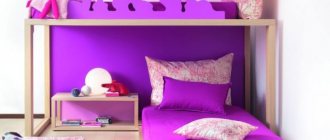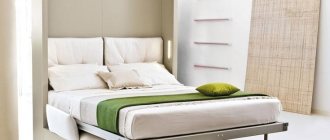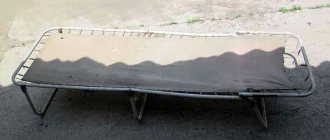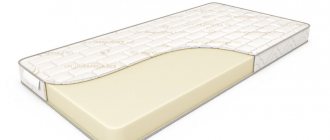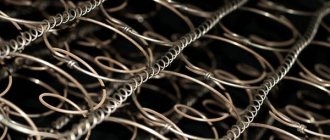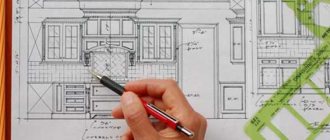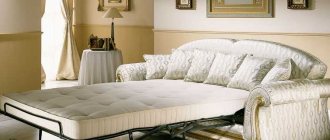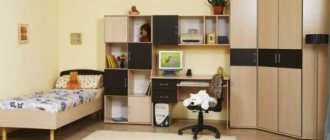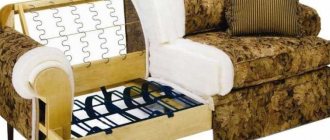17509
To create an original interior in a room, various fashionable innovations are used. The highlight of the bedroom will be a flying bed, which compares favorably with standard models. An airy, weightless floating bed is made with your own hands from available materials. Before developing a drawing, you need to familiarize yourself with the nuances of the work in order to avoid common mistakes.
Pros and cons of a floating bed
Being a very unusual piece of furniture in its structure and appearance, a floating bed has its own characteristics, advantages and disadvantages. Check out its pros and cons before you make your final decision whether you will make a floating bed for your bedroom or not.
A good addition to a floating bed would be LED lighting placed along its edges.
Let's start with the advantages.
- Building it yourself or buying a floating bed is the best way to make your bedroom unique and beautiful, especially in combination with the competent use of textiles, other furniture and various decorative elements.
- A floating bed, fixed to the floor and wall at the same time, is a strong, reliable and stable bed, despite the effect produced by its appearance.
- The materials that will be needed to create a floating bed can be obtained at any fairly large hardware store. This also applies to the tools needed to make a given piece of furniture.
- The ability to independently determine the size and shape of the future bed - a floating bed will not only have an unusual appearance, but also the length and width that you want.
Amazing flying bed
A bed near a large panoramic window creates a special feeling of floating in the air.
Also, anyone who wants a “levitating” bed for their bedroom should be aware of its possible shortcomings and problems, so that the results of long work or an expensive purchase do not become a source of bad emotions.
- A floating bed must be adjacent to the wall - just attaching it to the floor is not enough. This will somewhat limit your options for placing furniture in the bedroom.
- A bed with a “levitation” effect will not have space in its base for storing bed linen, blankets and pillows, like its “regular” counterparts.
- Any movement of such furniture will take more time and effort - after all, it is necessary to remove the fasteners, thanks to which the bed is fixed and becomes stable.
- Ready-made floating beds are very rare and therefore very expensive - you will most likely have to make one yourself, and this requires time, effort and sufficient skills in working with wood and metal.
Floating bed in a studio apartment
Original options for a floating bed
Having briefly examined the design of floating beds, their pros and cons, let’s move on to the process of their creation.
Magnetic Floating Bed
Types of bed designs with a floating effect
Floating furniture hangs in the air thanks to specific mounting methods.
- On one leg. A floating bed can only have one support in the center of the base. Decorative lighting distracts attention from the leg, which is already almost invisible due to its location. Sometimes rays radiate from the central support, which allow the weight to be evenly distributed. With this fastening, the product will withstand a load of up to 300 kilograms.
- On magnets. The author of floating magnetic furniture is the Dutch architect Janjaap Ruijssenaars. The designer's idea is based on the principle of magnetic levitation. Magnets are built into the frame of the product and into the floor, which keep it in the air. The floating sleeping bed stays in place thanks to four cables. The magnetic bed can support a weight of up to 600 kilograms. It is not suitable for people with pacemakers due to the magnetic field.
- On a metal frame. The main advantage of a metal frame is the reliability of the fastenings. The metal frame must be powder coated to prevent corrosion. Usually the metal frame is covered with a body made of MDF or solid wood.
- Suspended from the ceiling. The bed can be attached to the ceiling with strong ropes. This design has increased safety requirements. For a child's room, it is recommended to use steel cables instead of rope ropes.
- Attached to the wall. A headboard attached to the wall will give the structure additional stability.
“Flying” furniture looks weightless, as if challenging gravity.
The photo shows a hanging bed in an oriental style. Strong ropes hold the bed made of solid wood with layers of polymer resin.
Drawing up a design project for a floating bed
Making any furniture at home should begin with drawing up a project - determine what you want to get in the end, what size bed will suit you, what it should look like, what parts it should consist of, how these parts will be connected to each other and what material you will use make them.
In the attractive appearance of a “levitating” bed, the correct combination of colors of the furniture itself, textiles and decoration of the bedroom itself plays an important role.
Photo of a white flying bed
Important! Some of the work on manufacturing individual elements of a floating bed can be outsourced - to a workshop or to people who have sufficient experience, skills and tools to realize your ideas. This is especially worth doing if the support and frame of the furniture are made of metal profiles. But at the same time, be sure to prepare detailed drawings made according to the standards of design documentation - this way you will avoid possible discrepancies and related problems.
The very first stage of creating a floating bed begins with a general idea and selection of the approximate appearance of future furniture. To do this, look through photos and videos of already created samples, mark those that you liked more than others, pay attention to what materials they are made from, what their sizes are and how the craftsmen supplemented their design with decorative elements, textiles, and so on.
Photo of a floating bed
Often a floating bed is complemented by an expanded and reinforced headboard, which can be supplemented with shelves, a cabinet for a floor lamp or a laptop - this expands the functionality of the furniture and at the same time adds stability to it
Next, you need to decide on the approximate dimensions of the floating bed. To do this, take measurements of the bedroom and find out what size furniture you can install. Then select and purchase a mattress that suits you - this is what you should use as a starting point in the future when drawing up plans, drawings and when directly assembling a bed with the “levitation” effect.
Examples in various interior styles
Initially, floating furniture was intended for minimalist design, loft, and hi-tech. But designers have proven that the floating effect can fit perfectly into classic and vintage interiors. A hanging sleeping bed looks organically in oriental and Mediterranean interiors; light wood furniture is typical of Scandinavian design.
Materials needed to create a floating bed
The strength and durability of a “floating” bed largely depends on the materials used in its creation. First of all, we are talking about wood - the main material for any furniture. In the table below you can see brief characteristics of the main types of wood used in the assembly of beds and other furniture.
Table. Types of wood used to create furniture.
| Type of wood | Characteristics and what they are used for |
| Pine | One of the most common types of wood. Pine is resistant to rotting due to the abundance of resins, is well processed, and is quite convenient to work with. Use it to arrange the power elements of a floating bed - legs, frame, flooring under the mattress. Pine is not suitable for external decorative parts - it is difficult to paint it well. |
| Spruce | Its properties are similar to spruce, but less durable and prone to cracking. Suitable for creating furniture elements that are not subject to heavy loads. |
| Oak | Strong and durable material, equally well suited for both strength and decorative elements of a floating bed. Also, when processing, oak requires more time and effort compared to pine. |
| Beech | The wood is light yellow and pink in color with small fibers and is highly flexible (after processing). Like oak, beech is well suited for creating strength and decorative parts of a bed. |
| Larch | A very strong and durable type of wood - minimally susceptible to rotting. Suitable for making the support and frame of a floating bed. |
| Red tree | Many varieties of woods native to tropical areas. Due to their relative rarity, they are expensive and are used for external parts and furniture decoration. |
Important! In the case of a small budget allocated for the construction of a floating bed, instead of oak, beech or mahogany, chipboard panels can be used for external parts.
Chipboard panels of different colors
When creating the frame of a floating bed, wood can be replaced with square steel pipes - they are strong, lightweight and not too difficult to process and connect to each other. When deciding to use this material, give preference to products with a relatively large thickness of metal - a bed, especially a floating one, experiences high loads.
In addition to wood and metal, you may need material for a soft headboard - filling and upholstery. For the first, you can use foam rubber and its analogs, and for the second, fabric, leather or its substitutes, etc.
Headboard
When purchasing materials for a floating bed, do not forget about textiles - mattress, blanket, pillows, pillowcases, sheets and duvet cover. It is advisable to decide in advance on their design and combination with each other and with the finishing of the furniture itself.
Important! The mattress should be the very first item on your shopping list, and it is better to take it separately from everything else and even before starting to draw up a design project, since it is the mattress that will determine the dimensions of the future “levitating” bed.
Advantages and disadvantages
In addition to the unusual design, the flying bed has a number of other advantages:
- The risk of loosening or falling due to broken legs is completely eliminated. The frame is firmly attached to the wall.
- Along with other standard models, flying stocks look unusual and original.
- A wide selection of different designs will allow you to purchase a product to suit any style.
The disadvantages include the complexity of installation. You need to have some knowledge of carpentry and construction. A negative characteristic is the inability to equip drawers and storage shelves under the bed.
The use of a floating model obliges the housewife to carefully monitor the order in the house, otherwise even a two-day layer of dust will be visible to the naked eye.
Arranging a headband for a floating bed
The main part of the floating bed is ready. Now let's move on to another component of it, which is quite important - the headboard. In the case discussed in this section, not just a panel made of wood or chipboard will be created, but a headboard with soft upholstery and several shelves along the edges.
Step 1. To begin, attach sheets of plywood or OSB boards to the timber frame. Apply markings under the soft padding of the headband and buttons.
Markings are applied to the OSB sheet
Step 2. Attach foam rubber to the headboard plate with glue, cover it on the outside with padding polyester, and secure it with a construction stapler. Make holes for buttons on the headboard material and its soft filling.
Holes for buttons are marked
Holes are made
Step 3. Cover the headboard with fabric or any other material suitable for you over the foam rubber and padding polyester. At the same time, use its sections with a significant margin - this is necessary for subsequent fastening of the upholstery material with construction staples. Through pre-made holes, insert buttons with thick and strong threads into the headboard.
Buttons are inserted into the headboard
Finished upholstered headboard
Step 4. Connect the headboard with the support and bed frame, complement it with shelves, cabinets and other necessary elements.
The headboard is complemented by shelves
Upper frame and slats
The ease of use and durability of the bed largely depend on the slatted block, which takes on the weight of the mattress and the people lying on the bed. The frame of the block itself can either be made of wooden beams or have an all-welded metal structure. The second option is usually used in expensive bed models. Their high cost is more than compensated by the complete absence of unpleasant squeaks and an almost unlimited service life. In addition, the metal frame is much more reliable in places where lifts are attached, which take on serious loads.
Another important element of beds with lifting mechanisms are slats. They not only serve as support for the mattress, but are also responsible for improving its anatomical functions. Located at a certain distance from each other, the lamellas must be both rigid and elastic. In order for the slats to best perform their functions, they are made from multi-layer birch plywood. In high-quality bed models, slats made of five- or seven-layer plywood are installed. When choosing a lamella base, you need to pay attention to the distance between the lamellas. The smaller it is, the better. On average this figure is 5 cm.
Installing LED lighting
A good decoration for a floating bed can be LED lighting placed under the frame. Let's briefly look at how to do it.
Step 1. Unpack the LED strip, unfold it and connect the power supply to the network - check if it works and if there are any damaged areas. If the tape has brightness and color switching, try all its additional functions.
Checking the LED strip
Step 2. Arrange a place for the LED strip power supply under the bed, if you did not do this at the stage of assembling the frame.
Step 3. Remove the protective film from the adhesive part of a small section of the LED strip and stick it under the bed frame so that the LEDs themselves are not visible from the outside. Check if the tape is holding well. If yes, continue installing it as well. If not, use glue for this. Mount the LED strip around the entire perimeter of the bed.
LED strip mounted around the perimeter of the bed
Step 4. Place the power supply in a place prepared in advance for it, connect the plug to the network and turn on the LED strip. Adjust the brightness of the light and make sure everything is done properly.
Adjust the backlight brightness
Ready-made floating bed with lighting
Making a floating bed with your own hands requires a lot of effort and time, but as a result of successful work you will receive strong, comfortable, beautiful and unusual furniture that will decorate your bedroom. In addition, the experience gained in the process will help you create other unique furniture for your home.
5/5 (5)
Bed colors
The color of the furniture should match the color scheme of the house or apartment. Monochrome colors are suitable for the base and head of the sleeping bed: red, brown, beige. Wenge and zebrawood have been trending for years. If multi-color lighting is used, it is better to choose neutral colors such as black, white, gray.
